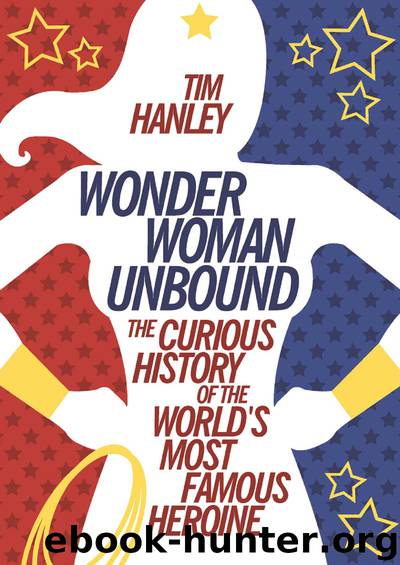Wonder Woman Unbound by Hanley Tim

Author:Hanley, Tim
Language: eng
Format: epub, mobi
Publisher: Chicago Review Press
Published: 2014-04-08T16:00:00+00:00
*Recent research by Carol Tilley shows that Wertham’s treatment of these teen testimonials was often sloppy. In one instance, he combined two separate anecdotes into one testimonial. Twice he overemphasized how the reader felt about Batman, omitting that one teen thought other comics characters better fulfilled his erotic fantasies and rewording another testimonial to put the focus more on Batman. This is problematic in terms of research methodology, but the fact remains that several gay teens read homoerotic undertones in Batman comics. The issue is one of degree, not whether or not teens read these undertones in the first place.
*As far as I can tell, this editorial doesn’t exist in any issue of Psychiatric Quarterly between 1941 and 1954, the years covering Wonder Woman’s first appearance to the publication of Seduction of the Innocent. Wertham was terrible at citations, and it’s possible the editorial comes from somewhere else, but I’ve searched every issue of Psychiatric Quarterly to no avail.
*His only exception was a case where two women in a prison experienced weight loss and a general deterioration of health because of “the excessive amount of passion response repeatedly evoked by their female lovers”—or, basically, having too much sex.
*The Golden and Silver Age Wonder Woman sounded a lot like Ron Burgundy, though I don’t think Wonder Woman ever exclaimed “By the beard of Zeus!”—and “Great Odin’s raven!” is a whole other pantheon.
*In Wonder Woman #131 in July 1962, Kanigher wrote a story explaining all of Wonder Woman’s expressions. Diana Prince said, “Sappho was so sensitive, she couldn’t stand the sight of suffering in any form,” and that’s why Wonder Woman says “Suffering Sappho!” However, a) that doesn’t make any sense, and b) that’s not at all what Sappho was known for.
*Statistics side note: These numbers are for the percentage of Wonder Woman’s lasso usage, not for the overall book. Given the shift to campy, fantastical stories in the Silver Age, you might think that Wonder Woman stopped lassoing people and started lassoing spaceships and giant birds instead. This could account for the difference, not the CCA. But when we look at the numbers per issue, we see that while lassoing people dropped from 5 percent of the panels per issue before the CCA to less than 1 percent after, the percentage of panels where Wonder Woman lassoed objects remained at 5 percent for both periods. Objects didn’t replace people; she tied up fewer people but the same number of objects, and the overall drop in the total use of her lasso came from tying up people far less often.
Download
This site does not store any files on its server. We only index and link to content provided by other sites. Please contact the content providers to delete copyright contents if any and email us, we'll remove relevant links or contents immediately.
4 3 2 1: A Novel by Paul Auster(12290)
The handmaid's tale by Margaret Atwood(7684)
Giovanni's Room by James Baldwin(7199)
Asking the Right Questions: A Guide to Critical Thinking by M. Neil Browne & Stuart M. Keeley(5654)
Big Magic: Creative Living Beyond Fear by Elizabeth Gilbert(5616)
Ego Is the Enemy by Ryan Holiday(5297)
The Body: A Guide for Occupants by Bill Bryson(4978)
On Writing A Memoir of the Craft by Stephen King(4866)
Ken Follett - World without end by Ken Follett(4647)
Adulting by Kelly Williams Brown(4489)
Bluets by Maggie Nelson(4478)
Eat That Frog! by Brian Tracy(4438)
Guilty Pleasures by Laurell K Hamilton(4363)
The Poetry of Pablo Neruda by Pablo Neruda(4041)
Alive: The Story of the Andes Survivors by Piers Paul Read(3970)
White Noise - A Novel by Don DeLillo(3955)
Fingerprints of the Gods by Graham Hancock(3943)
The Book of Joy by Dalai Lama(3904)
The Bookshop by Penelope Fitzgerald(3780)
